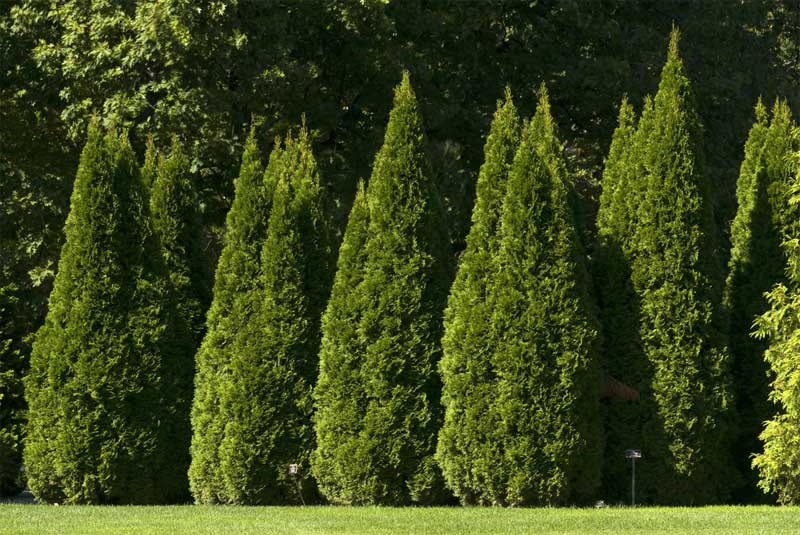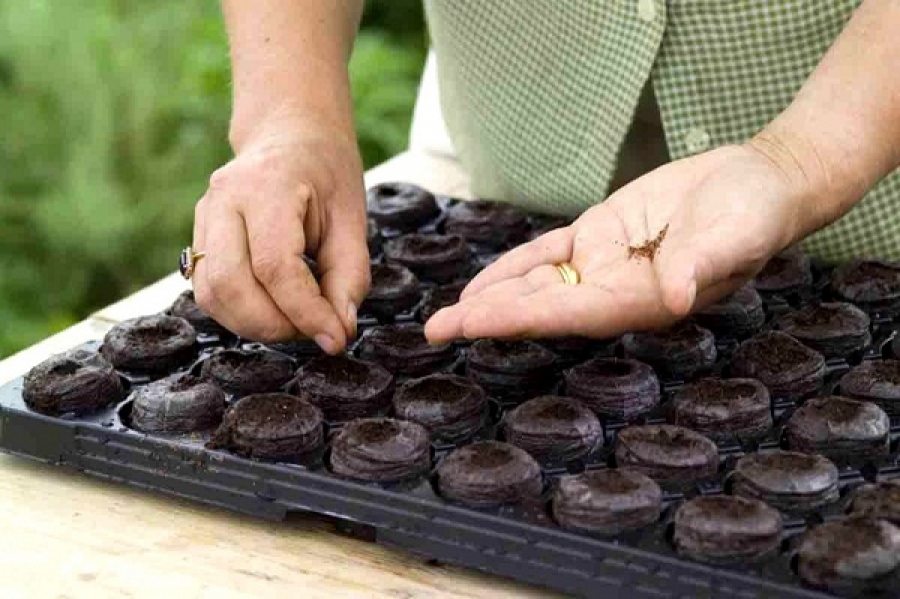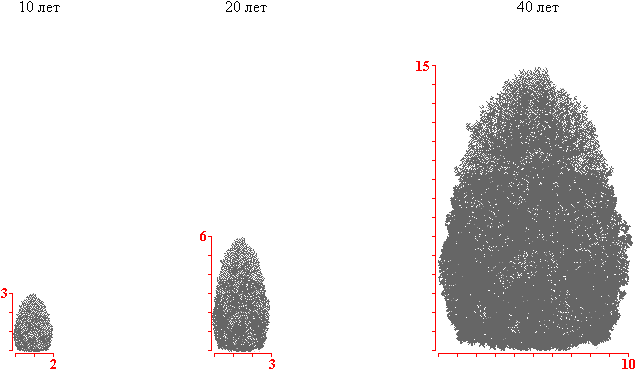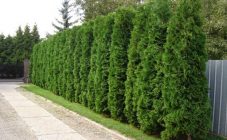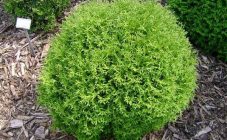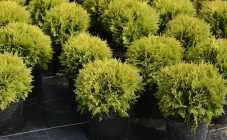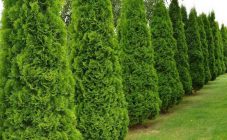Content:
Thuja western Miki (Mickey) is an evergreen plant that grows well in the middle lane. The sophistication and beauty of the crown, fresh scent served to spread this decorative tree, made it a frequent visitor of design compositions and plantings on the territory of private estates.
Description of Tui Miki
Thuja - "life tree" - refers to the genus Gymnosperms of conifers. Types of thuja differ in the shape of the crown and its size, the color of the needles. They grow as shrubs and tall trees. They attract amateur gardeners and professional designers not only for their beauty, but also for their unpretentious care, the ability to grow in the shade and withstand hot weather.
Characteristics of thuja western mickey
Her homeland is the territory of North America and Canada. The beauty and amazing properties of thuja attracted the attention of Europeans on the new mainland. The tree was transported to the Old World and began to spread across the continent.
There are several names for this type of thuja:
- western;
- thuya mickey
- thuja Mikey;
- thuya miki.
In Russia, at first, it grew only on the Black Sea coast, gradually took root, spreading to more northern regions.
Evergreen crown of thuja Miky (Thuja occidentalis Miky) with an ideal conical shape with a rather wide base and a sharp tip. In young seedlings, needle-like leaves, like needles, turn into bright green scales with age, which fit tightly to the branch.
The upright shoots are in the shape of slightly curled ridges.
In addition to the visual appeal, thuja Mickey has a number of other advantages:
- shade tolerance;
- undemanding to the quality of the soil;
- good resistance to urban conditions (presence of smoke and gas);
- frost resistance;
- the ability to tolerate short periods of too dry and wet weather;
- excellent tolerance to pruning;
- the possibility of growing in open ground and containers.
It grows slowly, gaining in height up to 8 cm per year.
Seat selection and landing
When planting, preference should be given to sunny areas or partial shade. There are no great requirements for the choice of soil, but it is better to plant on loamy soils without stagnant water. If a thuja grown in a container is planted in the ground, it must be well watered.
The soil removed from the pit is mixed with peat and sand in a ratio of 1: 1: 1, adding a complex mineral fertilizer: 5 g per 1 liter of soil mixture. Part of the mixture is laid out on the drainage, thuja is planted, the roots are well spread, and watered. The root collar should be at ground level. The trunk circle is mulched with peat.
There are two ways to reproduce to get a new copy:
Seeds
Seed propagation is a very time-consuming labor-intensive process that can take several years.Fresh planting material is stratified by placing it under the snow or in the refrigerator from autumn to spring. In the spring, they are planted in a half-shaded area, embedded to a depth of 0.5 cm, and a small layer of sawdust is poured on top. The planting is covered with shields from the sun's rays, they monitor the preservation of moisture under the shelter and the looseness of the soil.
After seed germination, the surface is mulched with peat. A solution of complete mineral fertilizer is applied every 2 weeks.
During the season, the seedlings grow by 7-8 cm. For the winter, the seedlings are covered with spruce branches and foil.
In the second year, the same activities are repeated as in the first season. Only in the third year, seedlings that have grown up to half a meter are planted in a permanent place.
Cuttings
The best option is propagation by cuttings in the summer, when the growth of shoots stops. This gives them an opportunity to get used to and take root for transplanting next season.
The process takes place in the following sequence:
- 2-3-year-old stalk is selected from the end of the shoot of a developed skeletal branch of the upper part of the plant 10-15 cm long;
- tear off together with the "heel", this will accelerate rooting;
- free cuttings from unnecessary needles;
- soak them in a solution of the drug to stimulate growth and rooting for 12 hours;
- planted in a container with prepared soil (light soil or sand), setting the cuttings at an angle of 45 ° and deepening by 1.5-2 cm;
- the soil is compacted and watered, covered with a film.
Further care
Thuja Mika's care includes:
- watering;
- weeding;
- feeding;
- pruning.
In the first year after planting, the root system still cannot take moisture and nutrients from the ground by itself, so you need to water the seedlings more often. In the future, it is recommended 1 watering per week during the dry period. To retain moisture, mulching is carried out with chips or pine bark with a layer of 5-7 cm. In this case, there will be less evaporation and it will be necessary to water if the top layer of the soil has dried.
Complex fertilizers for conifers are applied in the spring in April - May. You can use a nitroammophoska (30-40 g per 1 m²). Potash fertilizers will be needed in October. Lack of magnesium leads to a loss of bright green color and splendor of the crown.
Wintering
In late autumn, abundant watering is needed - a supply of moisture for the winter.
This variety is frost-resistant, but so that heavy snowfalls do not damage the crown, it is tied up. From mid to late winter, to protect against sunburn, the thuja is covered with spruce branches or agrofibre. Shelter is removed when the soil thaws. They do this on a cloudy day without wind.
Pruning and shaping the crown
Thuja treats pruning very well. After her, the crown becomes thicker and more magnificent. Pruning can be done in any season, but it is better to do it in the spring before bud break. Sometimes it is enough to carry out only the spring procedure for the formation of the crown.
The formation of the crown begins in the first year, since the thuja has a dense crown. It is better to do this in the summer after the end of growth activity and the appearance of new shoots or in the fall in preparation for winter.
There is an opinion that pruning is not necessary for Miki's thuja, she is able to form a crown on her own, but human intervention will help maintain a high aesthetics and decorative effect of the plantings.
Diseases and pests
Thuja Miki's diseases are primarily associated with improper care. When fungal diseases appear, treatment should be started immediately. The incurable late blight is especially dangerous. To combat it, the plant should be removed and burned, and the soil should be disinfected.
The following diseases are also dangerous for thuja:
- brown shoots;
- rust;
- shute;
- fusarium of roots.
In the event of an invasion of pests, trees are treated with insecticides (decis, actara). Thuya aphid, false shield, is especially annoying. In the fight against them, karbofos helps. To kill moth moths, drugs with pyrethroids are used. Spider mites are eliminated by treatment with acaricides. The wireworm is fought by treating the soil with products containing diazonin.
Use in landscape design
The miniature pyramid of thuja Mikey is paid attention to when creating landscape design compositions. Its presence adorns the diversity of the mixborder, emphasizes the splendor of flowering plants on the lawn, protects from wind and dust in the hedge. It will be useful to plant a thuja near a residential building, in a personal or summer cottage, since phytoncides refresh and heal the surrounding air.
Thuja planted in containers will emphasize the solemnity of events, decorate terraces, balconies and even roofs.
Thus, from the description of Mickey's thuja it is clear that it is unassuming to care for, easily pruned and looks spectacular on the site. Even a novice lover of conifers can grow it in a flower garden.
